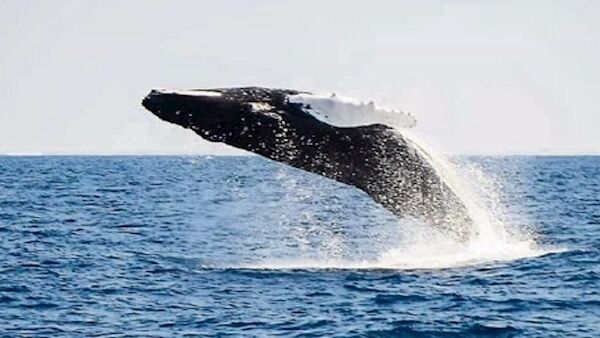Grandmother whales help in pod with rearing of young

When I read about whale grandmothers running creches for their grandchildren while their parents went out to work — ie to find and round up fish to feed the family — I was, of course both touched and intrigued.
In fact, it was less sentiment and more wonderment that attracted me to this newly ‘discovered’ and scientifically proven fact which indigenous sea-people, from Inuit Eskimos to South Pacific islanders have, no doubt, known for millennia.
It is truly wondrous that the females of four other species on Earth — all of them whales — follow the pattern of human females and, post menopause, help nurture, protect and feed a second generation, even perhaps a third.
The phenomenon is known as ‘the grandmother effect’.
In a study of orca whale females — which stop reproducing in their 30s or 40s but may live for decades more — this behaviour and its evolutionary benefit was clearly evident.
After menopause, they become grandmothers and in a study of 378 orca juveniles enjoying grandmother care 4.5% of those whose grandmothers die themselves die in the two years afterwards.
So, the phenomenon helps the survival of the young and of the species.
Why female whales should experience menopause is not entirely understood.
In orcas — killer whales — when mothers, pre-menopause, breed alongside daughters, the offspring of the older generation have a higher rate of mortality.
Also, if mothers continue to be sexually active alongside females of a second generation, conflict can arise.
It would seem that menopause in whales has a function beyond, but parallel to, the ‘grandmother effect’.
In mammal species that remain reproductive all their lives, there are also caring grandmothers — notably among elephants — that help their grandchildren.
While whale grandmothers may lead their charges to fish shoals and even feed them, grandmother elephants lead youngsters to good foraging locations and will trample paths to give them access to food supplies.
As we know, whales are extraordinary creatures in multiple ways. While doing a bit of reading up for this column, I came upon a dozen accounts of unique and fascinating whale behaviour.
Humpback whales ‘sing’ the same song year after year but add small variations until the melodies become too complex or too boring and are abandoned and are replaced by entirely new composition, which all develop and learn.
It’s the males that sing, hoping to attract females. Again, there are parallels in human and whale behaviour — the humpback beau singing, and his paramour listening, as in “And Mary, all smiling, sat listening to me...”.

Among whales, there are also the Miles Davis whales, the bowheads of the Greenland Sea.
They toot and flute, no two melodies the same, all improvisation and originality — not same-olds same-olds like instinctive mating calls, but changing year to year.
Bowheads outdo many songbirds in their repertoire of serenades breaking the silence of the months-long Arctic darkness.
Charlie ‘Bird’ Parker? How about Charlie ‘Bowhead’ Parker? It sounds good. I think he’d have liked it. He was a big man, who did a lot of smiling.
Tragically, the Spitzbergen group of bowheads that were studied now number 200; when first hunted in the 1600s they numbered 24,000. They can live for 200 years.
It was in the blubber of a bowhead, killed in 2007, that fragments of a ‘bomb lance’ — an explosive harpoon manufactured between 1879 and 1885 — was found.
Ivory and slate harpoons, probably even older, have also been found.
Almost every story of these magnificent creatures is, unfortunately, tragic. For example, there are only 30 north Pacific right whales left. Commercial, not indigenous, hunters almost wiped out the herds.

They were certainly ‘right’ for the commercial fleets, slow-moving, easy targets that, also, remained buoyant after being killed.
It is difficult not to succumb to anthropomorphism — attributing human characteristics to animals — when one considers the human-like characteristics of whales.
Indeed, sentimental as it is, maybe, in this case, sentiment engenders action toward their conservation.
A mother orca carrying her dead ‘child’ with her for two weeks, perhaps naively hoping it might come back to life.
Humpback whale mothers and their calves whispering to one another to avoid detection when predators are nearby. Yes: they touch the heart and play the heartstrings.
But the likely predators will be orcas, born killers. Nature remains red in tooth and claw.
Meanwhile, happy new year to my readers. As 2020 arrives here in La Gomera, Canary Islands, the sunsets over El Hierro, 50 miles to the west, are spectacular and the German holidaymakers take a million pictures.
They rival the sunsets over Courtmacsherry Bay on cloudless days.
At night, with the clear skies, the “floor of heaven”, as Shakespeare called it,“is thick inlaid with patines of bright gold”.












